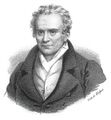Template:Selected anniversaries/August 28: Difference between revisions
No edit summary |
No edit summary |
||
| Line 12: | Line 12: | ||
File:Gaspard Monge.jpg|link=Gaspard Monge (nonfiction)|1802: Mathematician and engineer [[Gaspard Monge (nonfiction)|Gaspard Monge]] publishes new class of [[Gnomon algorithm functions]], based on his pioneering work in differential geometry, which detect and prevent [[crimes against mathematical constants]]. | File:Gaspard Monge.jpg|link=Gaspard Monge (nonfiction)|1802: Mathematician and engineer [[Gaspard Monge (nonfiction)|Gaspard Monge]] publishes new class of [[Gnomon algorithm functions]], based on his pioneering work in differential geometry, which detect and prevent [[crimes against mathematical constants]]. | ||
||1802: Ernst Anton Nicolai dies ... physician and chemist. He was a follower of Leibniz' concept of monadism, reportedly seeking solutions to medical problems based on the philosophic viewpoints of Gottfried Leibniz. | ||1802: Ernst Anton Nicolai dies ... physician and chemist. He was a follower of Leibniz' concept of monadism, reportedly seeking solutions to medical problems based on the philosophic viewpoints of Gottfried Leibniz. Pic search yes: https://www.google.com/search?q=Ernst+Anton+Nicolai | ||
||1820: Andrew Ellicott dies ... surveyor and urban planner. | ||1820: Andrew Ellicott dies ... surveyor and urban planner ... helped map many of the territories west of the Appalachians, surveyed the boundaries of the District of Columbia, continued and completed Pierre (Peter) Charles L'Enfant's work on the plan for Washington, D.C., and served as a teacher in survey methods for Meriwether Lewis. Pic. | ||
||1833: The Slavery Abolition Act 1833 receives royal assent, abolishing slavery through most of the British Empire. | ||1833: The Slavery Abolition Act 1833 receives royal assent, abolishing slavery through most of the British Empire. | ||
| Line 39: | Line 39: | ||
||1892: Thomas Henry Moray born ... inventor from Salt Lake City, Utah. He received a US patent 2,460,707 in February 1949, after a process of 17 years in discussions with the patent office. The main components of the patent were an LC circuit resonator and a set of vacuum power tubes of diode type using uranium and radium power sources and doped germanium semiconductors on the cathodes. It was an early example of doped semiconductors and a forerunner of radioactive power supplies using radioactive isotopes in space research. Moray's device followed other work on nuclear batteries first done in 1913 by Henry Moseley using a radium source. | ||1892: Thomas Henry Moray born ... inventor from Salt Lake City, Utah. He received a US patent 2,460,707 in February 1949, after a process of 17 years in discussions with the patent office. The main components of the patent were an LC circuit resonator and a set of vacuum power tubes of diode type using uranium and radium power sources and doped germanium semiconductors on the cathodes. It was an early example of doped semiconductors and a forerunner of radioactive power supplies using radioactive isotopes in space research. Moray's device followed other work on nuclear batteries first done in 1913 by Henry Moseley using a radium source. | ||
||1910: Paolo Mantegazza dies ... neurologist, physiologist, and anthropologist ... coca. Pic. | |||
||1910: Tjalling Koopmans born ... mathematician and economist Nobel Prize laureate. | ||1910: Tjalling Koopmans born ... mathematician and economist Nobel Prize laureate. | ||
Revision as of 16:44, 25 March 2019
413 BC: A lunar eclipse caused panic among the sailors of the Athens fleet and thus affected the outcome of a crucial battle in the Peloponnesian War. The Athenians were ready to withdraw their forces from Syracuse when the Moon was eclipsed, but the eclipse caused the superstitious Athenian general Nicias to delay their departure. This delay gave an advantage to their enemies, the Syracusans, who then defeated the entire Athenian fleet and army, and killed Nicias.
1801: Mathematician and philosopher Antoine Augustin Cournot born. He will introduce the ideas of functions and probability into economic analysis.
1802: Mathematician and engineer Gaspard Monge publishes new class of Gnomon algorithm functions, based on his pioneering work in differential geometry, which detect and prevent crimes against mathematical constants.
- C. Wright Mills.jpg
1916: Sociologist and author C. Wright Mills born. He will be published widely in popular and intellectual journals, advocating public and political engagement over disinterested observation.
1966: New study reveals that the Brainiac Explains lecture series is funded by a Brownian racket.
2019: Signed first edition of Three Kings sells for an undisclosed amount to "a couple, both eminent Gnomon algorith theorists and long-time residents of New Minneapolis, Canada."




